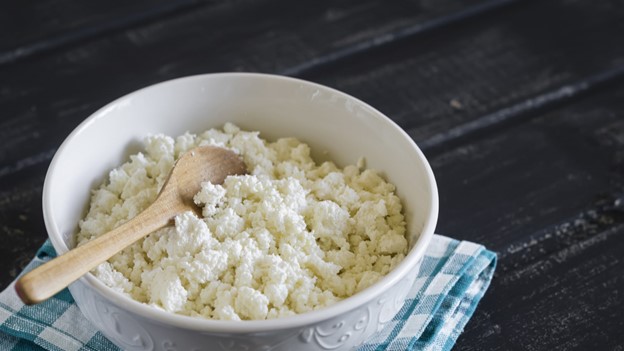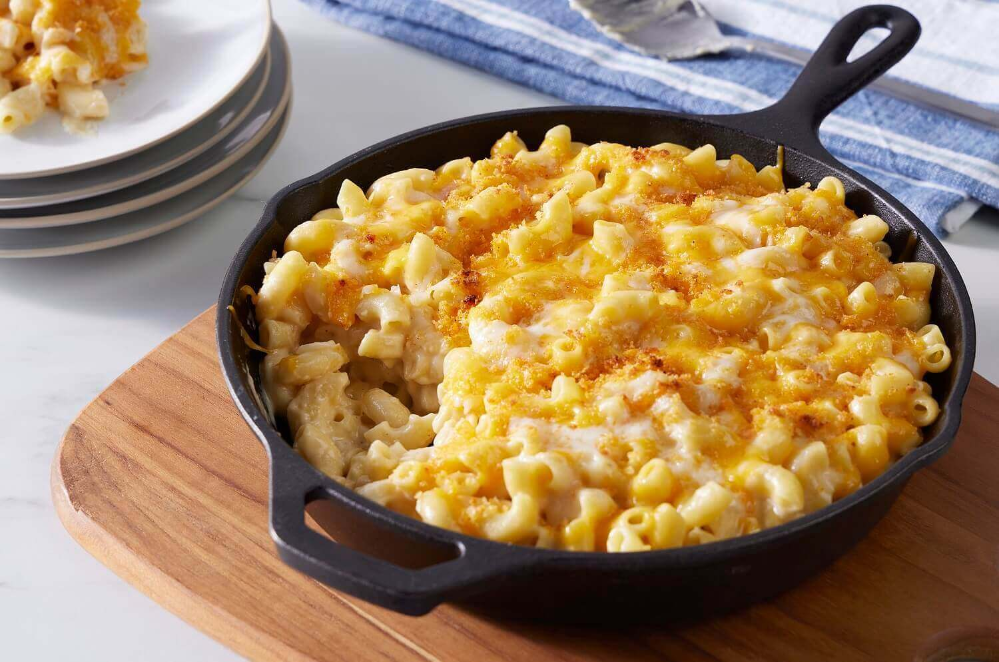It’s a Food That Just Doesn’t Let You Down!
Believed to have its origins in ancient Mesopotamia, cottage cheese as we know it today is a quintessentially American cheese. The new world version most likely took foothold in the small rural cottages where folks transformed naturally curdled milk from their family milk cow into soft cheese curds and then added milk or cream back to improve the flavor and consistency.

Cottage cheese, like many farmstead cheeses and processed foods, underwent an industrial transformation in the 1950’s. I recall eating lots and lots of cottage cheese with canned fruit in my youth (back in the 1960’s). My mother’s go-to dinner recipe when she was frazzled and running late was macaroni & cheese made with cottage cheese.
Wait. You can make mac ‘n cheese with COTTAGE cheese? Yes. Blending cottage cheese into the sauce makes the macaroni and cheese rich and creamy, but lower in fat and higher in protein. By blending all the ingredients together, you won’t even notice the base is made from cottag.e cheese! It’s a simple, delicious, and affordable recipe that only requires a few ingredients. Try this and see what you think.

8 ounces elbow pasta undercooked
1/2 cup 4% milkfat cottage cheese
1 cup milk
1 tablespoon cornstarch
1 1/2 cups shredded sharp cheddar cheese divided
1 teaspoon prepared mustard
1/4 teaspoon salt
1/8 teaspoon pepper
1/4 teaspoon garlic powder
1/4 teaspoon smoked paprika
1 cup Panko bread crumbs
Directions:
Add Recipe to Cook'n
You cottage cheese-lovers (and you don’t have to 86 years old, by the way) know it tastes great with fresh fruit, as part of a lunch salad plate, on toast or crackers as a snack, and is also a good replacement for ricotta cheese when making lasagna. It really is a versatile food.

I’ll close with one last thought regarding whether to choose low-fat or full-fat (aka 4%). The low-fat (called 2 percent) options have about 20 fewer calories than full-fat. The savings in saturated fat are similarly small, with 2 percent cottage cheese supplying 1.4 grams of saturated fat per half-cup.
Both low- and full-fat cottage cheese is made with a mixture of lactic acid-producing and citric acid-fermenting organisms, also known as probiotics. Some brands use fermented or live cultures, which are necessary to turn milk into yogurt. The curdling process used to produce both versions adds beneficial bacteria that can promote better gut health.

But the bottom line: Low-fat cottage cheese is a good choice for stirring into muffin, pancake, and waffle batters to add a protein boost. However, for the best flavor, whole-milk, creamy cottage cheese has a richness that is extra satisfying and a satiety that the low-fat version lacks. It’s a food that just doesn’t let you down!

Cottage cheese, like many farmstead cheeses and processed foods, underwent an industrial transformation in the 1950’s. I recall eating lots and lots of cottage cheese with canned fruit in my youth (back in the 1960’s). My mother’s go-to dinner recipe when she was frazzled and running late was macaroni & cheese made with cottage cheese.
Wait. You can make mac ‘n cheese with COTTAGE cheese? Yes. Blending cottage cheese into the sauce makes the macaroni and cheese rich and creamy, but lower in fat and higher in protein. By blending all the ingredients together, you won’t even notice the base is made from cottag.e cheese! It’s a simple, delicious, and affordable recipe that only requires a few ingredients. Try this and see what you think.
COTTAGE CHEESE Mac 'n Cheese

Ingredients:
8 ounces elbow pasta undercooked
1/2 cup 4% milkfat cottage cheese
1 cup milk
1 tablespoon cornstarch
1 1/2 cups shredded sharp cheddar cheese divided
1 teaspoon prepared mustard
1/4 teaspoon salt
1/8 teaspoon pepper
1/4 teaspoon garlic powder
1/4 teaspoon smoked paprika
1 cup Panko bread crumbs
Directions:
1. Cook the pasta according to package directions.
2. In a blender, combine the cottage cheese, milk, cornstarch, 1 cup cheddar cheese, mustard and seasonings. Blend until smooth.
3. Pour the cheese sauce into a skillet and heat over medium-low heat. Cook for 4-5 minutes until the sauce has thickened slightly.
4. When the pasta is ready, stir into the cheese sauce. Add additional seasoning to taste if desired. Stir well to combine.
5. Top mac ‘n cheese with Panko bread crumbs and
NOTES: You can use an immersion blender on the sauce to simplify the cleanup
2. In a blender, combine the cottage cheese, milk, cornstarch, 1 cup cheddar cheese, mustard and seasonings. Blend until smooth.
3. Pour the cheese sauce into a skillet and heat over medium-low heat. Cook for 4-5 minutes until the sauce has thickened slightly.
4. When the pasta is ready, stir into the cheese sauce. Add additional seasoning to taste if desired. Stir well to combine.
5. Top mac ‘n cheese with Panko bread crumbs and
NOTES: You can use an immersion blender on the sauce to simplify the cleanup
Recipe formatted with the Cook'n Recipe Software from DVO Enterprises.
You cottage cheese-lovers (and you don’t have to 86 years old, by the way) know it tastes great with fresh fruit, as part of a lunch salad plate, on toast or crackers as a snack, and is also a good replacement for ricotta cheese when making lasagna. It really is a versatile food.

I’ll close with one last thought regarding whether to choose low-fat or full-fat (aka 4%). The low-fat (called 2 percent) options have about 20 fewer calories than full-fat. The savings in saturated fat are similarly small, with 2 percent cottage cheese supplying 1.4 grams of saturated fat per half-cup.
Both low- and full-fat cottage cheese is made with a mixture of lactic acid-producing and citric acid-fermenting organisms, also known as probiotics. Some brands use fermented or live cultures, which are necessary to turn milk into yogurt. The curdling process used to produce both versions adds beneficial bacteria that can promote better gut health.

But the bottom line: Low-fat cottage cheese is a good choice for stirring into muffin, pancake, and waffle batters to add a protein boost. However, for the best flavor, whole-milk, creamy cottage cheese has a richness that is extra satisfying and a satiety that the low-fat version lacks. It’s a food that just doesn’t let you down!
 Alice Osborne
Alice Osborne
Weekly Newsletter Contributor since 2006
Email the author! alice@dvo.com
